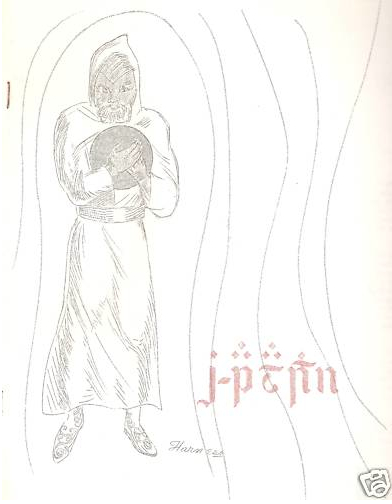Extollager
Well-Known Member
- Joined
- Aug 21, 2010
- Messages
- 9,046
My quest for a Mt. Doom - Mt. Elbrus connection
http://www.sffchronicles.co.uk/forum/546846-mt-doom-and-mt-elburz-in-the-caucasus.html
has led me to spend time lately with my odds and ends of old Tolkien fanzines. In case others are interested, here are some notes on the availability of vintage American Tolkien fanzines.
1.So far as I can tell, many of the vintage Tolkien-related fanzines from the 1950s and 1960s, such as Entmoot, are not available at all or else only occasionally as expensive items offered on ebay or at abebooks.com.
2.However, one can gain a sense of these fan-produced magazines by reading Hildifons Took's (Gary Hunnewell's) ongoing series of Tolkien Fandom Review issues, which are archived online. Here's the first review:
http://efanzines.com/TFR/TolkienFandom2ndEd.pdf
Here's a link to the whole series:
eFanzines.com - Tolkien Fandom Review
3.Hildifons/Gary has also made available a complete scan of what I would consider the single issue likeliest to qualify as the greatest early Tolkien fanzine issue, namely the 18th issue of Niekas, with a lengthy interview with Tolkien:
eFanzines.com - Niekas
4.The Mythopoeic Society sells photocopies or, in some cases,original printings (still?), of one of the best Tolkien fanzines, Tolkien Journal. Its own publications, Mythlore and Mythprint, have published much worthy Tolkien-related content.
Inactive Publications | Mythopoeic Society
Mythlore History | Mythopoeic Society
In my experience, orders for back issues may take months to fill, but given the very attractive pricing, this is no big deal. You see scattered single issues popping up for sale at much higher prices at abebooks.com.
5.A complete run of the longest-lived American Tolkien fanzine, the monthly newsletter Beyond Bree, is available for purchase, from March 1981 to the present. Contributors have included some notable Tolkien authorities such as Christina Scull, Nancy Martsch, Mark Hooker, and others. I recommend that you subscribe to this dependable 'zine!
Beyond Bree
6.A book that reprinted some fanzine material and was (I think) remaindered, so that used copies might not cost much:
The Tolkien Scrapbook - Tolkien Gateway
7.The above list emphasizes American fanzines. The England-based Tolkien Society has published Mallorn and Amon Hen for many years, but I began to receive these only a dozen or so years ago, and early issues seem unavailable unless one has very deep pockets, if then. I suppose there's much good content in these, but they might as well have sunk with Númenor for all the good they do me!
It would be interesting to hear from anyone who has knowledge of vintage Tolkien fanzines to share.
http://www.sffchronicles.co.uk/forum/546846-mt-doom-and-mt-elburz-in-the-caucasus.html
has led me to spend time lately with my odds and ends of old Tolkien fanzines. In case others are interested, here are some notes on the availability of vintage American Tolkien fanzines.
1.So far as I can tell, many of the vintage Tolkien-related fanzines from the 1950s and 1960s, such as Entmoot, are not available at all or else only occasionally as expensive items offered on ebay or at abebooks.com.
2.However, one can gain a sense of these fan-produced magazines by reading Hildifons Took's (Gary Hunnewell's) ongoing series of Tolkien Fandom Review issues, which are archived online. Here's the first review:
http://efanzines.com/TFR/TolkienFandom2ndEd.pdf
Here's a link to the whole series:
eFanzines.com - Tolkien Fandom Review
3.Hildifons/Gary has also made available a complete scan of what I would consider the single issue likeliest to qualify as the greatest early Tolkien fanzine issue, namely the 18th issue of Niekas, with a lengthy interview with Tolkien:
eFanzines.com - Niekas
4.The Mythopoeic Society sells photocopies or, in some cases,original printings (still?), of one of the best Tolkien fanzines, Tolkien Journal. Its own publications, Mythlore and Mythprint, have published much worthy Tolkien-related content.
Inactive Publications | Mythopoeic Society
Mythlore History | Mythopoeic Society
In my experience, orders for back issues may take months to fill, but given the very attractive pricing, this is no big deal. You see scattered single issues popping up for sale at much higher prices at abebooks.com.
5.A complete run of the longest-lived American Tolkien fanzine, the monthly newsletter Beyond Bree, is available for purchase, from March 1981 to the present. Contributors have included some notable Tolkien authorities such as Christina Scull, Nancy Martsch, Mark Hooker, and others. I recommend that you subscribe to this dependable 'zine!
Beyond Bree
6.A book that reprinted some fanzine material and was (I think) remaindered, so that used copies might not cost much:
The Tolkien Scrapbook - Tolkien Gateway
7.The above list emphasizes American fanzines. The England-based Tolkien Society has published Mallorn and Amon Hen for many years, but I began to receive these only a dozen or so years ago, and early issues seem unavailable unless one has very deep pockets, if then. I suppose there's much good content in these, but they might as well have sunk with Númenor for all the good they do me!
It would be interesting to hear from anyone who has knowledge of vintage Tolkien fanzines to share.
Last edited:



